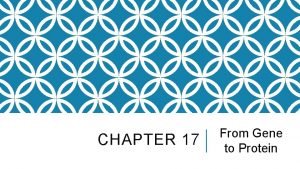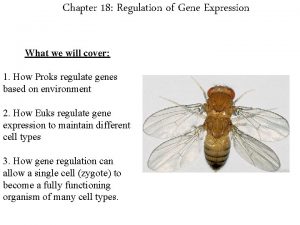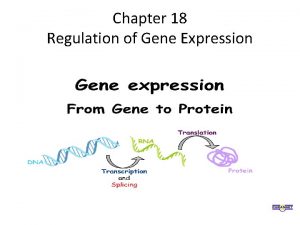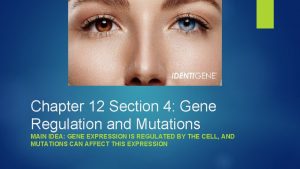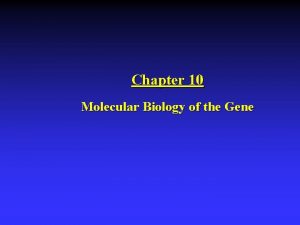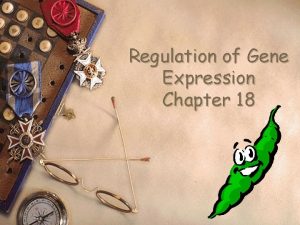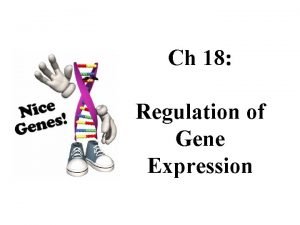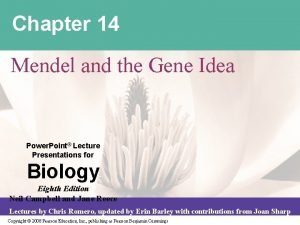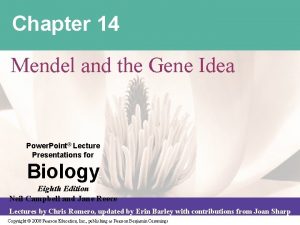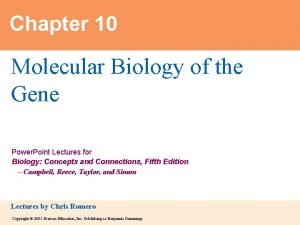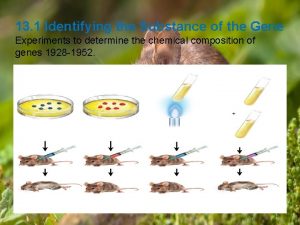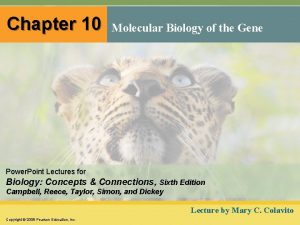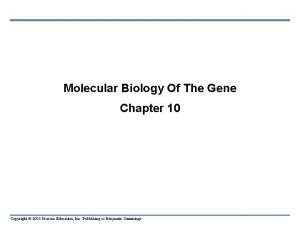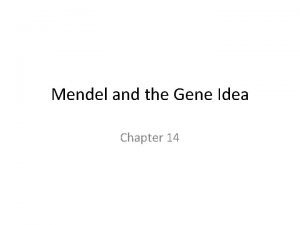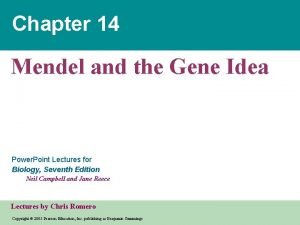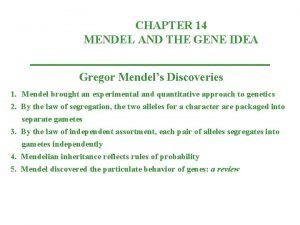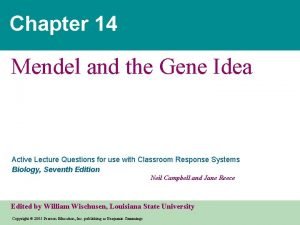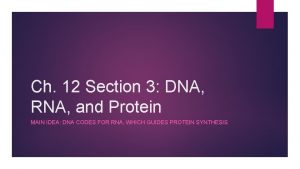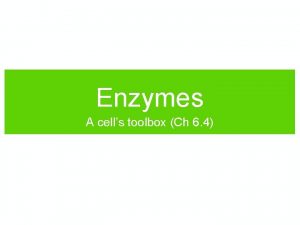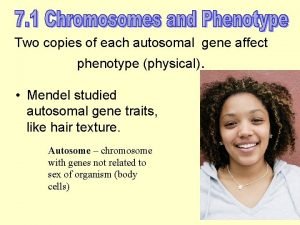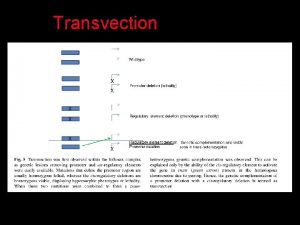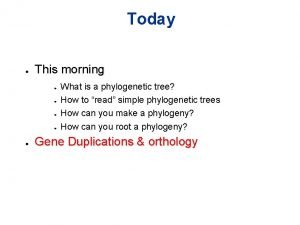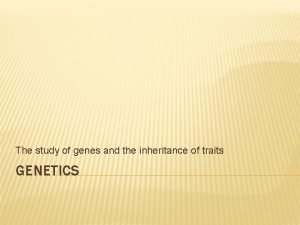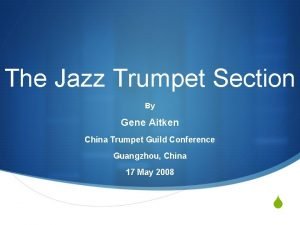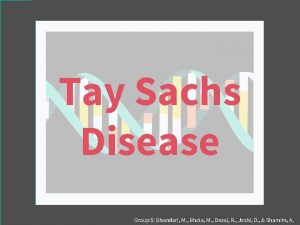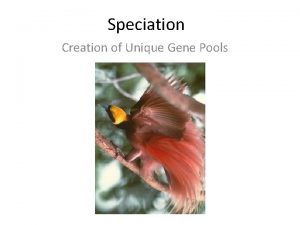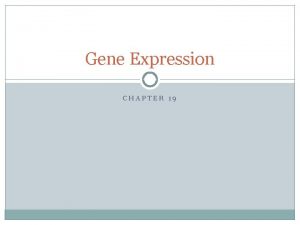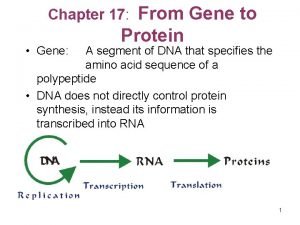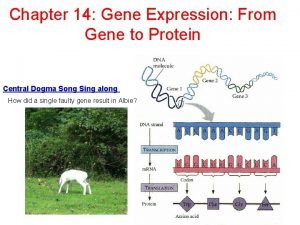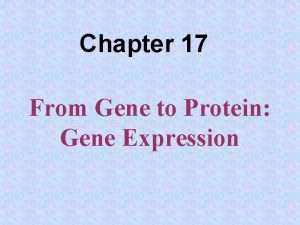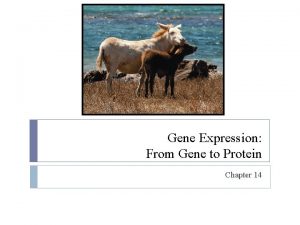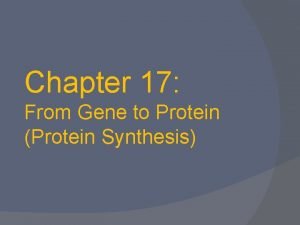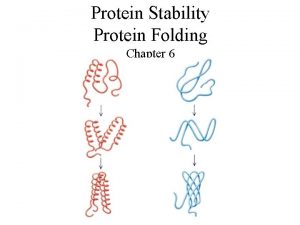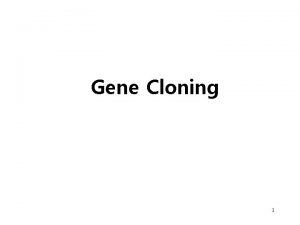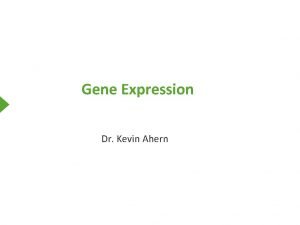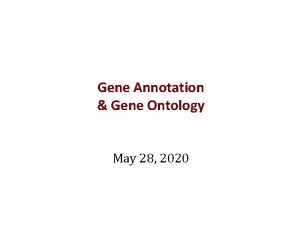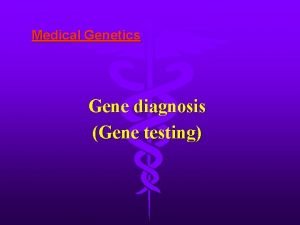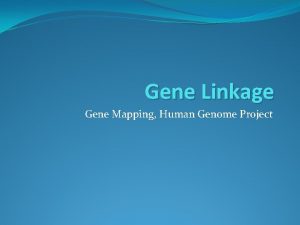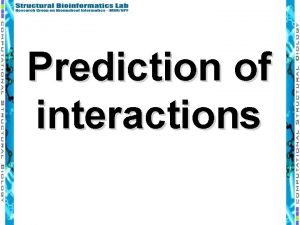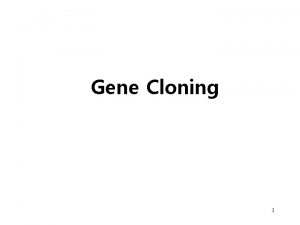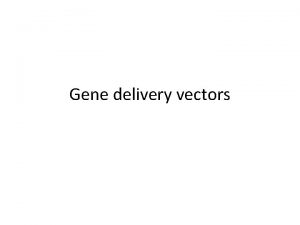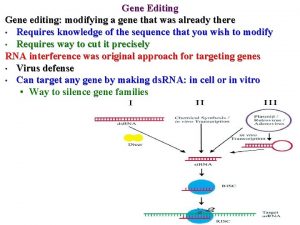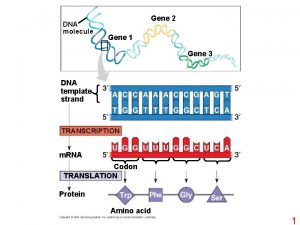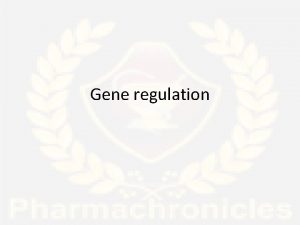Chapter 17 From Gene to Protein What do
































- Slides: 32

Chapter 17: From Gene to Protein

What do genes code for? n How does DNA code for cells & bodies? u DNA how are cells and bodies made from the instructions in DNA proteins All the traits of the body

The “Central Dogma” • Flow of genetic information in a cell – How do we move information from DNA to proteins? DNA n io t p i r sc tran replication RNA tr n tio a l s an protein trait

RNA • • Monomers = nucleotides Phosphate Ribose sugar Nitrogen Bases – uracil instead of thymine • U bonds with A • C bonds with G • single stranded DNA transcription RNA

Compare DNA and RNA DNA RNA Shape Double helix 2 strands Single strand Sugar Deoxyribose Ribose Bases A, T, C, and G A, U, C and G Location Only in the nucleus Allowed to travel from nucleus to cytoplasm

Types of RNA • Ribosomal RNA (r. RNA) – Major component of ribosomes • Transfer RNA (t. RNA) – Folded upon itself – Carries the amino acids to the m. RNA • Messenger RNA (m. RNA) – Sequence of nucleotides that determines the primary sequence of the polypeptide – Made in the nucleus from the DNA: transcription • sn. RNA (small-nuclear “snurps”) – Forms the “spliceosomes” which are used to cut out introns from pre-m. RNA • si. RNA (small-interfering) – targets specific m. RNA and prohibits it from being expressed

Protein Synthesis: From gene to protein nucleus a a a cytoplasm a a DNA transcription m. RNA a a translation a a a protein a a a ribosome trait

Which gene is read on the DNA? • Promoter region – binding site before beginning of gene – Generally referred to as a TATA box because it is a repeating sequence of T and A – binding site for RNA polymerase & transcription factors • Enhancer region – binding site far upstream of gene • Speeds up process

Transcription Factors – transcription factors bind to promoter region of DNA • proteins • can be activated by hormones (cell signaling) • turn on or off transcription – triggers the binding of RNA polymerase to DNA

Transcription: DNA to m. RNA • Takes place in the nucleus • A section of DNA is unzipped • RNA polymerase lays down nucleotides 5’ to 3’ direction. • The m. RNA then leaves the nucleus through the nuclear pores and enters the cytoplasm

Coding strand = this is the protein needed or “sense strand” Template strand = this is the “anti-sense strand”

Eukaryotic genes have untranscribed regions! • m. RNA must be modified before it leaves the nucleus – exons = the real gene • expressed / coding DNA introns come out! – introns = non-coded section • in-between sequence • Spliceosomes cut out introns with ribozyme intron = noncoding (inbetween) sequence eukaryotic DNA exon = coding (expressed) sequence

Alternative splicing • • • Same piece of DNA can be read many different Not all the exons may make it to the final product Intron presence can determine which exons stay or go Increases efficiency and flexibility of cell sn. RNA’s have big role in alternative splicing Starting to get hard to define a gene!

Final m. RNA processing… • Need to protect m. RNA on its trip from nucleus to cytoplasm (enzymes in cytoplasm attack m. RNA) • protect the ends of the molecule • add 5 GTP cap • add poly-A tail – longer tail, m. RNA lasts longer il a t -A y l o p 3' ap 5' c 5' G P P P m. RNA A A 50 50 -2 A A ’s 3'

The Transcriptional unit enhancer 1000+b 3' 20 -30 b RNA TATA polymerase translation start TAC translation stop exons transcriptional unit (gene) 5' DNA ACT DNA introns promoter transcription start transcription stop 5' pre-m. RNA 5' GTP mature m. RNA 3' 3' AAAA

Genetic Code • Genetic code is based on sets of 3 nucleotides …called CODONS! – Read from the m. RNA – 64 different possible combinations exist • Only 20 amino acids commonly exist in the human body – Some codons code for the same amino acids (degenerate or redundant) • Sequence of codons determines the sequence of the polypeptide • Code is “almost” universal…same for all organisms (evolutionary heritage)

The Code • You don’t need to memorize the codons (except for AUG) n Start codon u u n AUG methionine Stop codons u UGA, UAG

m. RNA codes for proteins in triplets DNA TACGCACATTTACGCGG codon m. RNAAUGCGUGUAAAUGCGCC ? protein Met. Arg. Val. Asn. Ala. Cys. Ala

How is the code “translated? ” Process of reading m. RNA and creating a protein chain from the code.

Ribosomes: Site of Protein Synthesis • Facilitate coupling of t. RNA anticodon to m. RNA codon • Structure – ribosomal RNA (r. RNA) & proteins – 2 subunits • large • small E P A

Ribosomes: 3 binding sites • A site (aminoacyl-t. RNA site) – holds t. RNA carrying next amino acid to be added to chain • P site (peptidyl-t. RNA site) – holds t. RNA carrying growing polypeptide chain • E site (exit site) Met – Empty t. RNA leaves ribosome from exit site 5' U A C A U G

Transfer RNA Found in cytoplasm Carries amino acids to ribosome Contains an “anticodon” of nitrogen bases Anticodons use complementary bond with codons Less t. RNA’s than codons, so one t. RNA may bind with more than one codon. • Supports the degenerate code • “Wobble” hypothesis: anticodon with U in third position can bind to A or G • • •

Translation: m. RNA to Protein • In the cytoplasm ribosomes attach to the m. RNA – Ribosome covers 3 codons at a time • Initiation - The t. RNA carrying an amino acid comes into P-site and bonds by base pairing its anti-codon with the m. RNA start codon (what is the start codon? ) • Elongation – The second t. RNA then comes into A-site and bonds to codon of m. RNA – The two amino acids joined with peptide bond • Termination – ribosome continues reading m. RNA until a STOP codon is reached (doesn’t code for anything) Mc. Graw Hill Animations

Building a polypeptide • Initiation – m. RNA, ribosome subunits, initiator t. RNA come together • Elongation – adding amino acids based on codons Good Overview animation • Termination 3 2 1 – STOP codon = Release factor Val Leu Met Met Leu Ala Leu release factor Ser Trp A C t. RNA G U AC 5' CUGAA U m. RNA A U G 3' E P A 5' U A C G A C AA U G CU G 5' 3' U A C GA C A U G C UG AAU 3' 5' U A C G A C AA U AU G C U G 3' A CC U GG U A A 3'

RNA polymerase DNA Can you tell the story? amino acids exon pre-m. RNA intron t. RNA 5' GTP cap mature m. RNA poly-A tail large ribosomal subunit polypeptide 5' small ribosomal subunit t. RNA E P A ribosome 3'

Prokaryote vs. Eukaryote Differences • Prokaryotes – DNA in cytoplasm – circular chromosome – naked DNA – no introns – No splicing – Promoter & terminator sequence – Smaller ribosomes • Eukaryotes – DNA in nucleus – linear chromosomes – DNA wound on histone proteins – introns and exons – TATA box promoter – Transcription factors present

Protein Synthesis in Prokaryotes • Transcription & translation are simultaneous in bacteria – Both occur in cytoplasm – no m. RNA editing – ribosomes read m. RNA as it is being transcribed

Mutations

Mutations • Point mutations – single base change • silent mutation – no amino acid change – redundancy in code • missense – change amino acid – Changes the final protein • nonsense – change to stop codon – Stopping prematurely When do mutations affect the next generation?

Point mutation lead to Sickle cell anemia What kind of mutation? What structure has the mutation? RNA or DNA

Mutations • Frameshift – shift in the reading frame • changes everything “downstream” – insertions • adding base(s) – deletions • losing base(s) Where would this mutation cause the most change: beginning or end of gene?

 Chapter 17 from gene to protein
Chapter 17 from gene to protein Chapter 17 from gene to protein
Chapter 17 from gene to protein Chapter 17 from gene to protein
Chapter 17 from gene to protein Gene by gene test results
Gene by gene test results Carrier vs channel proteins
Carrier vs channel proteins Protein-protein docking
Protein-protein docking Chapter 18 regulation of gene expression
Chapter 18 regulation of gene expression Chapter 18 regulation of gene expression
Chapter 18 regulation of gene expression Section 4 gene regulation and mutations
Section 4 gene regulation and mutations Chapter 10 molecular biology of the gene
Chapter 10 molecular biology of the gene Chapter 18 regulation of gene expression
Chapter 18 regulation of gene expression Ch 18
Ch 18 Mendel and the gene idea chapter 14
Mendel and the gene idea chapter 14 Chapter 14 mendel and the gene idea
Chapter 14 mendel and the gene idea Sexual reproduction and genetics section 1 meiosis
Sexual reproduction and genetics section 1 meiosis Chapter 10 molecular biology of the gene
Chapter 10 molecular biology of the gene Chapter 13 lesson 1 identifying the substance of the gene
Chapter 13 lesson 1 identifying the substance of the gene Molecular biology of the gene chapter 10
Molecular biology of the gene chapter 10 Plant viruses
Plant viruses Chapter 14 mendel and the gene idea
Chapter 14 mendel and the gene idea Chapter 14: mendel and the gene idea
Chapter 14: mendel and the gene idea Chapter 14 mendel and the gene idea
Chapter 14 mendel and the gene idea Chapter 14 mendel and the gene idea
Chapter 14 mendel and the gene idea Chapter 12 section 3 dna rna and protein
Chapter 12 section 3 dna rna and protein Chapter 12 enzymes the protein catalyst
Chapter 12 enzymes the protein catalyst Gene woodard
Gene woodard Difference between autosomes and sex chromosome
Difference between autosomes and sex chromosome Hox gene mutation in drosophila
Hox gene mutation in drosophila Gene tree vs phylogenetic tree
Gene tree vs phylogenetic tree Are brown eyes dominant over green
Are brown eyes dominant over green Gene aitken
Gene aitken Tay
Tay Hox gene mutation in drosophila
Hox gene mutation in drosophila


